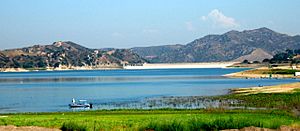Santiago Dam facts for kids
Quick facts for kids Santiago Dam |
|
|---|---|

Santiago Dam, viewed from the eastern end of the lake
|
|
|
Location of Santiago Dam in California
|
|
| Country | United States |
| Location | Orange County, California |
| Coordinates | 33°47′10″N 117°43′31″W / 33.78611°N 117.72528°W |
| Construction began | 1929 (Irvine Company, Serrano Irrigation District) |
| Opening date | 1931 |
| Owner(s) | Serrano Water District/Irvine Ranch Water District |
| Dam and spillways | |
| Type of dam | Roller-compacted earth and rock fill |
| Impounds | Santiago Creek |
| Height | 136 ft (41 m) |
| Length | 1,425 ft (434 m) |
| Width (crest) | 29 ft (8.8 m) |
| Width (base) | 760 ft (230 m) |
| Dam volume | 790,000 cu yd (600,000 m3) |
| Spillway type | Uncontrolled concrete overflow |
| Spillway capacity | 31,700 cu ft/s (900 m3/s) |
| Reservoir | |
| Creates | Irvine Lake |
| Total capacity | 38,800 acre⋅ft (47,900,000 m3) (max) 25,000 acre⋅ft (31,000,000 m3) (conservation) |
| Catchment area | 64 sq mi (170 km2) |
| Surface area | 700 acres (280 ha) |
| Power station | |
| Hydraulic head | 120 ft (37 m) |
| Installed capacity | None |
The Santiago Dam, also called the Santiago Creek Dam, is a large structure built across Santiago Creek. You can find it in Orange County, California. This dam creates a big lake called Irvine Lake.
The Santiago Dam is made of earth and rock. It stands about 136-foot (41 m) tall. The main jobs of this dam and its lake are to control floods and offer fun activities. It's located near the cities of Orange and Irvine. Irvine Lake is the biggest freshwater lake completely within Orange County.
Contents
Building the Santiago Dam
When Was the Dam Built?
Work on the Santiago Dam began in 1929. Two groups, the Irvine Company and Serrano Irrigation District, worked together. They first prepared the land. Then, they used dirt and rocks from the canyon sides to build the dam.
How Long Did Construction Take?
The dam was finished in 1931. It cost about $1 million to build. By 1933, Irvine Lake was full of water. In the late 1930s, fish were put into the lake. The lake opened for public fun in 1941.
Why Was the Dam Needed?
The dam was built to help with three main things. It helped control floods and provided water for farms. It also supplied water for people to use in their homes. Over time, more homes were built downstream. Because of this, farming near Santiago Creek mostly stopped.
Who Owns the Dam Now?
Today, the Irvine Ranch Water District and the Serrano Water District own the dam. The Serrano Water District used to be the Serrano Irrigation District. The dam now marks where Santiago Creek's surface water usually ends. All the water is held in the lake. Only a little bit of water flows out below the dam, like seepage or during storms.
Facts and Figures About the Dam
How Big is the Santiago Dam?
The Santiago Dam is a huge structure made of earth and rock. It is 136 feet (41 m) high. The dam stretches 1,425 feet (434 m) long. At its base, it is about 760 feet (230 m) wide. The dam contains about 790,000 cubic yards (600,000 m3) of material.
What is the Spillway?
The dam has a concrete spillway on its left side. A spillway is like a safety valve for the dam. It has nine openings, each 15 feet (4.6 m) wide and 28 feet (8.5 m) high. This spillway can let out a lot of water, over 30,000 cubic feet per second (850 m3/s). The spillway has only been used a few times. This happened during big floods in 1938, 1969, 1983, 1998, and 2005. The very top of the dam is 804 feet (245 m) above sea level.
About Irvine Lake
Irvine Lake is the reservoir behind the dam. It normally holds 25,000 acre-feet (31,000,000 m3) of water. This is when the water level is at 791 feet (241 m) elevation. During a flood, it can hold up to 28,000 acre-feet (35,000,000 m3). This lake is the largest human-made lake in Orange County. It is also the biggest freshwater lake entirely in the county. The lake covers about 700 acres (280 ha). Many kinds of fish live in the lake. You do not need a fishing license to fish here.
How Does the Dam Get Water?
The dam and lake collect water from a large area. This area is about 64 square miles (170 km2). This means the dam controls water from about two-thirds of the Santiago Creek area. The Santiago Dam is built to hold back a 50-year flood. It can also stand strong during a 500-year flood. This means it can handle over 30,000 cubic feet per second (850 m3/s) of water.
Other Water Sources and Dams
Besides Santiago Creek, other streams flow into the lake. These include Limestone Wash and other small streams. Upstream, Silverado and Modjeska Creeks also feed Santiago Creek. The Santiago Dam works with another dam downstream. This is the Villa Park Dam. Villa Park Dam can store up to 15,600 acre-feet (19,200,000 m3) of water. It is designed to stay dry during normal weather. It holds back most of the floodwater released from Santiago Dam.


